Elite life

Mushrooms
Lactarius
║ Mushrooms ║
Saffron Milk Cap, Red Pine Mushroom (Lactarius deliciosus)
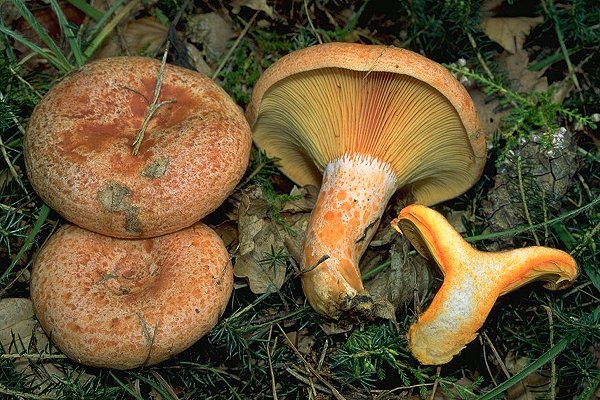
Cap 3-10 cm across, convex then shallowly funnel-shaped, with numerous small purplish-brick to salmon blotches arranged in narrow, concentric bands on a pale flesh or rosy buff background, becoming tinged greenish in places, slightly sticky, firm, brittle, margin incurved at first. Stem 30-60 x 15-20 mm, pale buff or vinaceous to orangy or salmon, sometimes with darker, shallow, spot-like depressions, becoming green in places. Flesh pale yellowish, carrot in places from the milk (after one hour or so) fading and finally dull greyish green. Gills slightly decurrent, closely spaced, pale pinkish apricot to saffron, becoming carrot and slowly dull pistachio green on bruising. Milk carrot; taste mild or slightly bitter. Spore print pale ochre. Spores elliptic, with thin to thickish ridges forming a fairly full network, 7-9 x 6-7 μm.
Lactarius corrugis
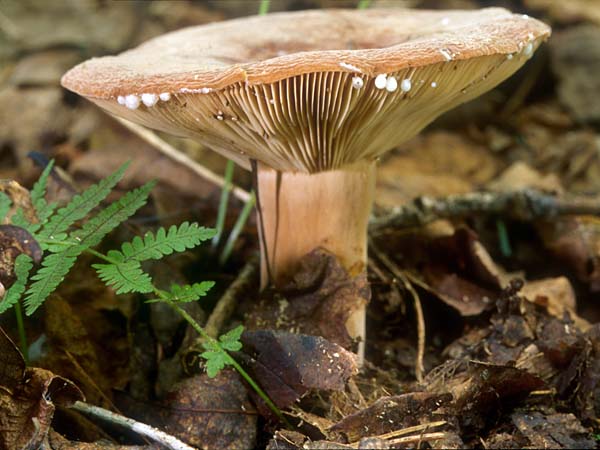
Cap 4-13 cm across, convex becoming depressed, sometimes with a distinctly wrinkled margin; dark reddish brown to yellowish brown, sometimes paler at the margin; dry and velvety. Gills adnate to subdecurrent, close, quite broad, some forking; white to pale yellowy or buff, brown when bruised. Stem 40-110 x 15-25 mm, solid; paler than cap, gray-brown sometimes tinged red-brown; dry, velvety. Flesh firm; white staining brown. Latex white, unchanging, abundant, staining tissues brown when cut. Odor slight. Taste mild. Spores globose, amyloid, 9-13 x 9-13 μm; ornamented with an almost complete reticulum, prominences 0.4-0.7 μm, high. Deposit white.
Lactarius hygrophoroides
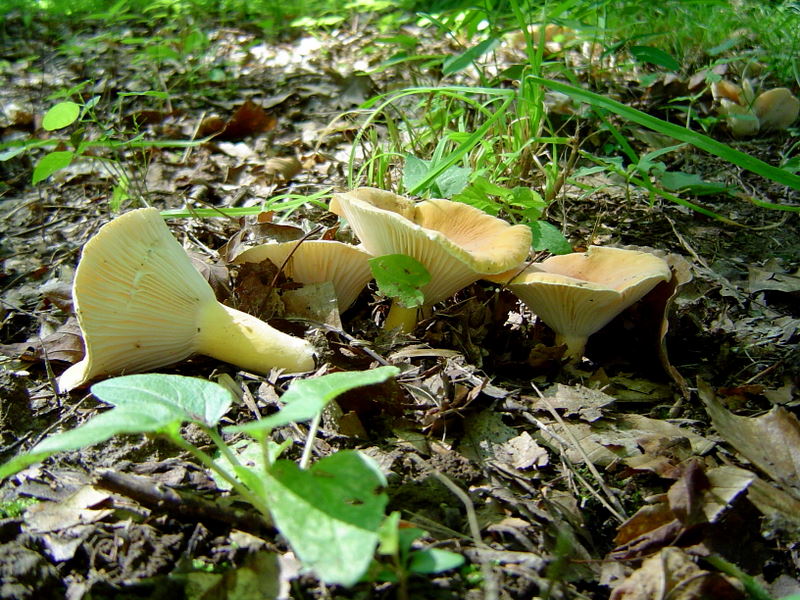
Cap 3-10 cm across, convex with a depressed center, becoming flatter and sometimes funnel-shaped, with an incurved then spreading margin; orangy brown to reddish brown; dry and velvety, becoming wrinkled in age. Gills adnate-subdecurrent, distant, broad; white becoming cream or pale yellowy fawn. Stem 30-50 x 5-15 mm, stuffed or solid; same color as cap or paler; dry with a white bloom. Flesh firm; white. Latex white, plentiful, unchanging, not staining. Odor mild. Taste mild. Spores ellipsoid, amyloid, 7.5-9.5 x 6-7.5 μm; ornamented with small warts connected by fine lines sometimes forming a broken reticulum, prominences 0.2-0.4 μm high. Deposit white.
Indigo Milky (Lactarius indigo)
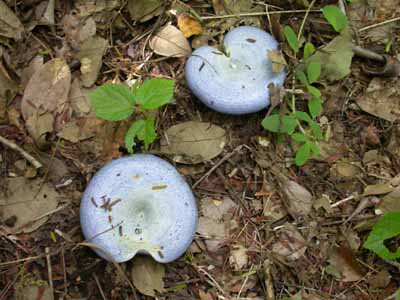
Cap 5-15 cm across, convex-depressed with an inrolled margin at first; indigo blue when fresh, fading to grayish, then having a silvery luster, with deep green areas where bruised; sticky, smooth, zoned. Gills adnate, close, broad; indigo blue or paler to yellowish from the maturing spores, staining green when bruised. Stem 20-80 x 1-25 mm, hard becoming hollow, often tapered toward the base; indigo blue to silver blue, spotted at times; sticky but soon dry. Flesh whitish, promptly turning indigo blue when cut, staining greenish. Latex deep indigo blue, becoming dark green on exposure to the air. Odor mild. Taste mild or slightly bitter or slightly acrid. Spores broadly ellipsoid to subglobose, amyloid, 7-9 x 5.5-7.5 μm, ornamented with a complete or broken reticulum, prominences 0.4-0.5 μm high. Deposit cream.
Bleeding Milk Cap (Lactarius rubrilacteus)
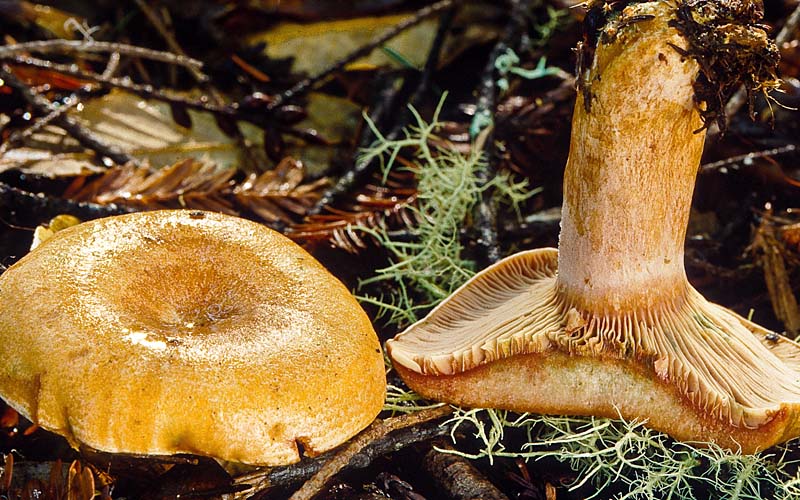
Pileus: Cap 5.0-12 cm broad, convex, margin inrolled when young, becoming plano-convex to shallowly infundibuliform in age; surface viscid when moist, banded concentrically with shades of orange; often developing green discolorations in age; flesh thick, brittle, bleeding a sparse, dark red latex when cut; taste and odor mild.
Lamellae: Gills decurrent, narrow, close to crowded, dull orange, bleeding a dark red latex.
Stipe: Stipe 2-5 cm tall, 1.0-2.5 cm thick, solid and brittle when young, hollow in age, equal to tapered at the base; surface smooth, unpolished, dull orange-buff, bruising green where handled.
Spores: Spores 7-9 x 6-7.5 μm, ovoid with amyloid reticulations; spore print pale yellow. Edibility: Edible.
Lactarius scrobiculatus
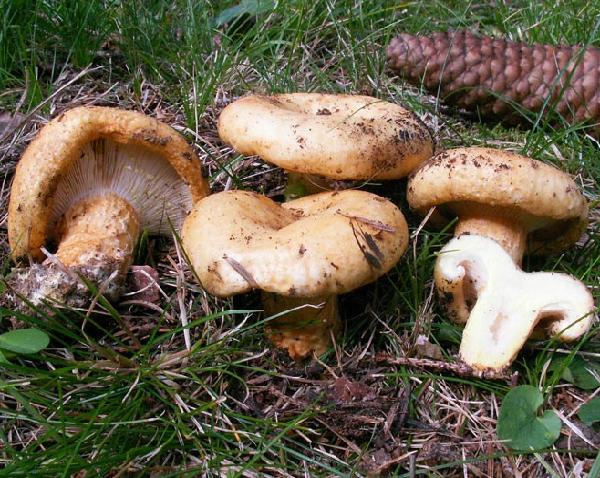
Variegated Milky Cap (Lactarius subpurpureus)

Cap 3-10 cm across, convex then flat to depressed; with concentric bands of color wine-red to silvery ochre with age, staining green; smooth, slightly viscid when wet. Gills adnate; wine-red at first, then paler, bruising green. Stem 30-80 x 6-15 mm, same color as the cap but with darker red spots; smooth, slightly sticky. Flesh white or pinkish, staining red then slowly green. Latex wine-red. Odor pleasant. Taste slightly peppery. Spores ellipsoid, amyloid, 8-11 x 6.5-8 μm; ornamented with a reticulum. Deposit pale cream.
Vachette, Vachotte (Lactarius volemus)
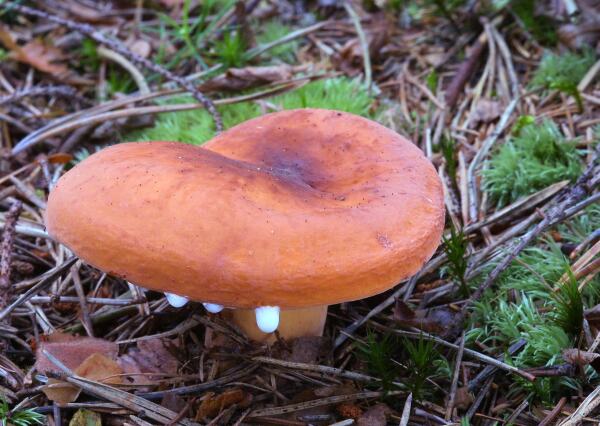
Cap 5-11 cm across, convex with a depression, coloured apricot to tawny, fleshy, firm, shortly velvety to smooth, not sticky. Stem 40-120 x 10-30 mm, concolorous with cap, but usually paler, shortly velvety to smooth, solid. Flesh whitish, firm. Gills slightly decurrent, narrow, somewhat closely spaced, easily breaking, pale golden yellow, bruising brown. Gill cystidia abundant, with thick, wavy walls. Milk white, abundant; taste mild. Smell fishy. Spore print whitish. Spores spherical; ridges thick, a few thin, forming a complete network, 8-10 x 8-9.5 μm. Cap surface cellular, cap and stem surfaces with spindle-shaped, tapering cystidia.
║ Mushrooms ║